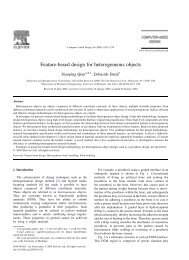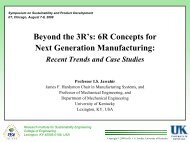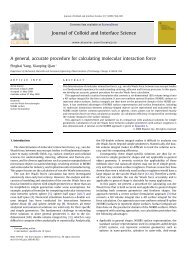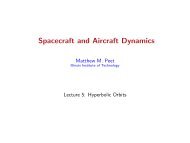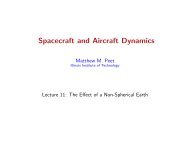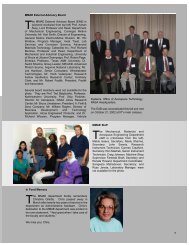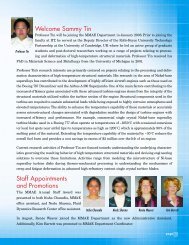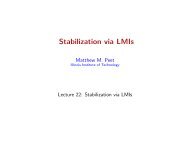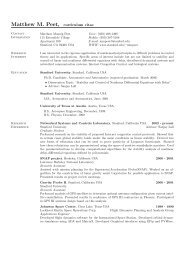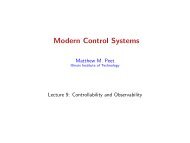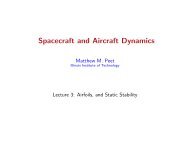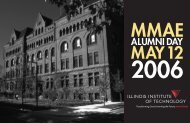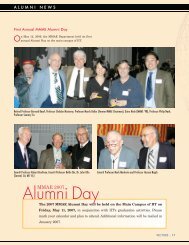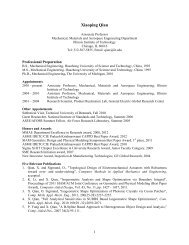from discrete points to continuous spline paths - Mechanical ...
from discrete points to continuous spline paths - Mechanical ...
from discrete points to continuous spline paths - Mechanical ...
Create successful ePaper yourself
Turn your PDF publications into a flip-book with our unique Google optimized e-Paper software.
(a)(b)Figure 4: Two sets of synthetic data used in the experiments: (a) a sinusoidal surface;(b) a wavy surface.(a)(b)Figure 5: Two sets of real data used in the experiments: (a) a compound surface; (b) aface like surface.12
4020CL <strong>points</strong>CL pathProjected CC <strong>points</strong>z0-200 25 50 75 100x(a)(c)(e)0.150.100.050.00-0.00-0.05-0.10-0.150.150.100.050.00-0.00-0.05-0.10-0.15(b)(d)(f)Figure 7: CL <strong>paths</strong> and CL <strong>points</strong> generated <strong>from</strong> a wavy surface: (a) isometric view ofinput <strong>points</strong> and CL <strong>paths</strong>; (b) the CL path, interpolated CL <strong>points</strong>, and correspondingCC <strong>points</strong>; (c) normal curvatures along the forward direction; (d) <strong>to</strong>p view of CL <strong>points</strong>and CL <strong>paths</strong>; (e) normal curvatures along the side direction; (f) <strong>to</strong>p view of CL <strong>paths</strong>.16
6040CL <strong>points</strong>CL pathProjected CC <strong>points</strong>z2000 25 50 75 100 125x(a)(b)(c)(e)0.200.150.100.050.00-0.00-0.08-0.16-0.24-0.320.280.210.140.070.00-0.00-0.08-0.16-0.24-0.32(d)(f)Figure 8: CL <strong>paths</strong> and CL <strong>points</strong> generated <strong>from</strong> a compound surface: (a) isometricview of input <strong>points</strong> and CL <strong>paths</strong>; (b) the CL path, interpolated CL <strong>points</strong>, andcorresponding CC <strong>points</strong>; (c) normal curvatures along the forward direction; (d) <strong>to</strong>pview of CL <strong>points</strong> and CL <strong>paths</strong>; (e) normal curvatures along the side direction; (f) <strong>to</strong>pview of CL <strong>paths</strong>.17
240CL <strong>points</strong>CL pathProjected CC <strong>points</strong>z220200(a)(c)(e)0.150.100.050.00-0.00-0.05-0.10-0.150.150.100.050.00-0.00-0.05-0.10-0.151800 50 100 150x(b)(d)(f)Figure 9: CL <strong>paths</strong> and CL <strong>points</strong> generated <strong>from</strong> a face like surface: (a) isometricview of input <strong>points</strong> and CL <strong>paths</strong>; (b) the CL path, interpolated CL <strong>points</strong>, andcorresponding CC <strong>points</strong>; (c) normal curvatures along the forward direction; (d) <strong>to</strong>pview of CL <strong>points</strong> and CL <strong>paths</strong>; (e) normal curvatures along the side direction; (f) <strong>to</strong>pview of CL <strong>paths</strong>.18
Maximum deviations of CL <strong>paths</strong>5.2 x 10-354.84.4Sequence number of CL <strong>paths</strong>Maximum deviations of CL <strong>paths</strong>5.2 x 10-354.84.4Sequence number of CL <strong>paths</strong>40 25 50 75 10040 25 50 75 100(a)(b)Figure 10: Deviations of CL <strong>paths</strong> generated <strong>from</strong> the sinusoidal surface: (a) CL <strong>paths</strong>obtained by enforcing the <strong>to</strong>lerance only at midspan <strong>points</strong>; (b) CL <strong>paths</strong> obtained byour method.7 x 10-3 Sequence number of CL <strong>paths</strong>6 x 10-3 Sequence number of CL <strong>paths</strong>Maximum deviations of CL <strong>paths</strong>654Maximum deviations of CL <strong>paths</strong>5430 25 50 75 100 12530 25 50 75 100 125(a)(b)Figure 11: Deviations of CL <strong>paths</strong> generated <strong>from</strong> the wavy surface: (a) CL <strong>paths</strong>obtained by enforcing the <strong>to</strong>lerance only at midspan <strong>points</strong>; (b) CL <strong>paths</strong> obtained byour method.19
Maximum deviations of CL <strong>paths</strong>0.0150.010.005Maximum deviations of CL <strong>paths</strong>6 x 10-354Sequence number of CL <strong>paths</strong>00 50 100 150 200Sequence number of CL <strong>paths</strong>(a)30 50 100 150 200(b)Figure 12: Deviations of CL <strong>paths</strong> generated <strong>from</strong> the compound surface: (a) CL <strong>paths</strong>obtained by enforcing the <strong>to</strong>lerance only at midspan <strong>points</strong>; (b) CL <strong>paths</strong> obtained byour method.Maximum deviations of CL <strong>paths</strong>7 x 10-3 Sequence number of CL <strong>paths</strong>654Maximum deviations of CL <strong>paths</strong>6 x 10-3 Sequence number of CL <strong>paths</strong>5430 50 100 150 200 250 30030 50 100 150 200 250 300(a)(b)Figure 13: Deviations of CL <strong>paths</strong> generated <strong>from</strong> the face like surface: (a) CL <strong>paths</strong>obtained by enforcing the <strong>to</strong>lerance only at midspan <strong>points</strong>; (b) CL <strong>paths</strong> obtained byour method.20
Number of interpolation <strong>points</strong>300250200150100B-<strong>spline</strong> <strong>paths</strong>Linear <strong>paths</strong>Number of interpolation <strong>points</strong>20015010050B-<strong>spline</strong> <strong>paths</strong>Linear <strong>paths</strong>Number of interpolation <strong>points</strong>500 25 50 75 100Sequence number of CL <strong>paths</strong>300250200150100(a)B-<strong>spline</strong> <strong>paths</strong>Linear <strong>paths</strong>500 50 100 150 200Sequence number of CL <strong>paths</strong>(c)Number of interpolation <strong>points</strong>250200150100500 25 50 75 100 125Sequence number of CL <strong>paths</strong>(b)B-<strong>spline</strong> <strong>paths</strong>Linear <strong>paths</strong>0 50 100 150 200 250 300Sequence number of CL <strong>paths</strong>(d)Figure 14: Bounded by the same interpolation <strong>to</strong>lerance, the number of interpolation<strong>points</strong> of B-<strong>spline</strong> CL <strong>paths</strong> and the number of interpolation <strong>points</strong> of linear CL <strong>paths</strong>:Deviations of CL <strong>paths</strong> generated <strong>from</strong> a face like surface: (a) the sinusoidal surface;(b) the wavy surface; (c) the compound surface; (d) the face like surface.As Fig. 14 shows, the number of interpolation <strong>points</strong> of B-<strong>spline</strong> CL <strong>paths</strong> is smallerthan the number of interpolation <strong>points</strong> of linear CL <strong>paths</strong>, where all the <strong>paths</strong> arebounded by the same <strong>to</strong>lerance. As Table 5 shows, the <strong>to</strong>tal number of interpolation<strong>points</strong> of our B-<strong>spline</strong> <strong>paths</strong> is less than 25% of that of linear <strong>paths</strong> for the sinusoidalsurface, less than 31% of that of linear <strong>paths</strong> for the wavy surface, less than 48% of tha<strong>to</strong>f linear <strong>paths</strong> for the compound surface, and less than 42% of that of linear <strong>paths</strong> forthe face like surface.6 CONCLUSIONThis paper presents an approach for generating B-<strong>spline</strong> CL <strong>paths</strong> directly <strong>from</strong> <strong>discrete</strong><strong>points</strong>. The method for calculating the single <strong>to</strong>ol path is suitable for any PSSsrepresented by implicit forms. An ODE representation of NC <strong>paths</strong> is introduced <strong>to</strong>produce CL <strong>points</strong> on the driving plane directly <strong>from</strong> the implicit MLS surface. By theprocesses of inserting and removing interpolation <strong>points</strong>, a compact set of interpolation21
Table 5: Number of interpolation <strong>points</strong> of CL <strong>paths</strong>B-<strong>spline</strong> <strong>paths</strong>Examples Linear <strong>paths</strong> n In n InReSinusoidal surface 26,637 6,581 6,563Wavy surface 19,993 6,270 6,185Compound surface 39,951 20,276 18,785Face like surface 42,424 18,564 17,467<strong>points</strong> is obtained for each CL path such that the number of interpolation <strong>points</strong> isreduced and the B-<strong>spline</strong> path interpolated satisfies a given <strong>to</strong>lerance. Our approach ismore accurate than conventional methods since it checks the point with the maximumdeviation in each curve segment of CL <strong>paths</strong> instead of the point at the midspan of eachcurve segment. The method for calculating the side step between consecutive <strong>paths</strong> issuitable for part surfaces in different forms provided that the closest distance <strong>from</strong> apoint <strong>to</strong> the part surface can be calculated. The step size is determined such that themaximum scallop height along a scallop curve coincides with a given <strong>to</strong>lerance.Computational experiments demonstrate that the approach produces high-quality B-<strong>spline</strong> <strong>paths</strong> <strong>from</strong> a variety of noisy point cloud data. The resultant <strong>paths</strong> are curvatureadaptive and satisfy specified <strong>to</strong>lerances.Our future work would be <strong>to</strong> experimentally verify this method on high-speed CNCmachines and <strong>to</strong> run the formulations of the method on parallel processes <strong>to</strong> improvethe efficiency.ACKNOWLEDGMENTSWe gratefully acknowledge the financial support <strong>from</strong> NSF grants (#0900597 and #1030347).References[1] Tikhon, M., Ko, T., Lee, S., and Sool Kim, H., 2004. “NURBS interpola<strong>to</strong>r forconstant material removal rate in open NC machine <strong>to</strong>ols”. International Journalof Machine Tools and Manufacture, 44(2-3), pp. 237–245.[2] Tsai, M., Nien, H., and Yau, H., 2008. “Development of an integrated look-aheaddynamics-based NURBS interpola<strong>to</strong>r for high precision machinery”. Computer-Aided Design, 40(5), pp. 554–566.[3] Lin, A., and Liu, H., 1998. “Au<strong>to</strong>matic generation of NC cutter path <strong>from</strong> massivedata <strong>points</strong>”. Computer-Aided Design, 30(1), pp. 77–90.22
[4] Park, S., and Chung, Y., 2003. “Tool-path generation <strong>from</strong> measured data”.Computer-Aided Design, 35(5), pp. 467–475.[5] Park, S., 2004. “Sculptured surface machining using triangular mesh slicing”.Computer-Aided Design, 36(3), pp. 279–288.[6] Feng, H., and Teng, Z., 2005. “Iso-planar piecewise linear NC <strong>to</strong>ol path generation<strong>from</strong> <strong>discrete</strong> measured data <strong>points</strong>”. Computer-Aided Design, 37(1), pp. 55–64.[7] Chui, K., Chiu, W., and Yu, K., 2008. “Direct 5-axis <strong>to</strong>ol-path generation <strong>from</strong>point cloud input using 3D biarc fitting”. Robotics and Computer-Integrated Manufacturing,24(2), pp. 270–286.[8] Zhang, D., Yang, P., and Qian, X., 2009. “Adaptive NC path generation <strong>from</strong>massive point data with bounded error”. Journal of Manufacturing Science andEngineering, 131, p. 011001.[9] Tam, H., Xu, H., and Zhou, Z., 2002. “Iso-planar interpolation for the machiningof implicit surfaces”. Computer-Aided Design, 34(2), pp. 125–136.[10] Lartigue, C., Thiebaut, F., and Maekawa, T., 2001. “CNC <strong>to</strong>ol path in terms ofB-<strong>spline</strong> curves”. Computer-Aided Design, 33(4), pp. 307–319.[11] Jin, Y., Wang, Y., Feng, J., and Yang, J. “Research on consecutive micro-lineinterpolation algorithm with local cubic B-<strong>spline</strong> fitting for high speed machining”.In Mechatronics and Au<strong>to</strong>mation (ICMA), 2010 International Conference on, IEEE,pp. 1675–1680.[12] Erkorkmaz, K., and Altintas, Y., 2001. “High speed CNC system design. Part I:jerk limited trajec<strong>to</strong>ry generation and quintic <strong>spline</strong> interpolation”. InternationalJournal of machine <strong>to</strong>ols and manufacture, 41(9), pp. 1323–1345.[13] Vijayaraghavan, A., Sodemann, A., Hoover, A., Rhett Mayor, J., and Dornfeld,D., 2010. “Trajec<strong>to</strong>ry generation in high-speed, high-precision micromilling usingsubdivision curves”. International Journal of Machine Tools and Manufacture,50(4), pp. 394–403.[14] Amenta, N., and Kil, Y., 2004. “Defining point-set surfaces”. ACM Transactionson Graphics, 23(3), pp. 264–270.[15] Choi, B., and Jerard, R., 1998. Sculptured surface machining: theory and applications.Kluwer Academic.[16] Lasemi, A., D., X., and Gu, P., 2010. “Recent development in CNC machining offreeform surfaces: A state-of-art review”. Computer-Aided Design, 42(7), pp. 641–654.23
[17] Levin, D., 2003. “Mesh-independent surface interpolation”. Geometric Modelingfor Scientific Visualization, 3, pp. 37–49.[18] Alexa, M., Behr, J., Cohen-Or, D., Fleishman, S., Levin, D., and Silva, C., 2003.“Computing and rendering point set surfaces”. IEEE Transactions on Visualizationand Computer Graphics, 9(1), pp. 3–15.[19] Yang, P., and Qian, X., 2008. “Adaptive slicing of moving least squares surfaces:<strong>to</strong>ward direct manufacturing of point set surfaces”. Journal of Computing andInformation Science in Engineering, 8, p. 031003.[20] Sarma, R., and Dutta, D., 1997. “The geometry and generation of NC <strong>to</strong>ol <strong>paths</strong>”.Journal of <strong>Mechanical</strong> Design, 119, pp. 253–258.[21] Yang, P., and Qian, X., 2007. “Direct computing of surface curvatures for point-setsurfaces”. In Eurographics symposium on point-based graphics, pp. 29–36.VITAEYu Liu is a postdoc<strong>to</strong>ral of Huazhong University of Science and Technology and aresearch associate of Illinois Institute of Technology. He received an undergraduatedegree in mechatronic engineering <strong>from</strong> Tianjin University, China in 2000 and a doc<strong>to</strong>r’sdegree in the mechatronic engineering of Huazhong University of Science and Technology,China in 2008. His research interests include reverse engineering, CAD/CAM, anddigital manufacturing.Songtao Xia is a PhD student at the department of <strong>Mechanical</strong>, Materials and AerospaceEngineering at IIT. He received his BS degree in mechanical engineering <strong>from</strong> HuazhongUniversity of Science and Technology, China in 2008 and MS degree <strong>from</strong> The GeorgeWashing<strong>to</strong>n University in 2010. His current research interests focus on geometric processingof massive point-cloud data.Xiaoping Qian is an associate professor in the Department of <strong>Mechanical</strong>, Materialsand Aerospace Engineering at IIT. He received his Ph.D. in mechanical engineering <strong>from</strong>the University of Michigan, Ann Arbor in 2001. His research interests lie in the generalarea of computational design.24



